Let us now connect the idea of our longing for the God of the universe, and our very Creator, to be with us in some meaningful way despite our fallen condition, and our separation being bound within space-time.
The chart below adds to our previous Old Testament Timeline the periods and circumstances of God’s presence with His people. Shown in the gray boxes are the periods during which God’s name was manifested to the Jewish people. Immediately after the Exodus (deliverance from slavery in Egypt under the leadership of Moses) God gave The Law to the people. This of course included the still famous 10 Commandments. But God also revealed many other laws and conditions upon His redeemed people including the establishment of a place where God’s name would be specifically identified. Starting about 1400 B.C. this place was a contained within a portable, tent structure known as the Tabernacle. Some 500 years later a permanent building was established on a mount outside of Jerusalem by King Solomon using materials previously gathered for such purpose by his father Kind David. This Temple was destroyed by a Babylonian King some 400 years later. After a gap of some70 years, God orchestrated a return to Jerusalem and the rebuilding of the Temple and later the walls of the Temple and the city of Jerusalem. This reconstructed Temple is commonly referred to as “the 2nd Temple.” Beginning about 50 years before the birth of Christ, this 2nd Temple was expanded and beautified by a Roman appointed king of Judea (Herod the Great). It was this expanded Temple which Jesus would have seen during His few visits to Jerusalem, and where His followers testified of His resurrection and the establishment of a New Covenant.
Beginning about 50 years before the birth of Christ, this 2nd Temple was expanded and beautified by a Roman appointed king of Judea (Herod the Great). It was this expanded Temple which Jesus would have seen during His few visits to Jerusalem, and where His followers testified of His resurrection and the establishment of a New Covenant.
This final manifestation of the Temple was substantially destroyed in 70 A.D. by a Roman army putting down a Jewish revolt. Later, in about 135 A.D. there was yet another Jewish revolt and a subsequent, total destruction of even the meager remains of the Temple and of the walls of the city of Jerusalem, leaving it all as ruins. Over the course of now some 2,000 years since the city has been rebuilt, damaged, and rebuilt / damaged over and over again. During much of that time the population of Jerusalem was very small, very poor. Since the time of the rise of Islam (since ca 650 A.D.), Muslim peoples have sought to control the city and environs, which it has done for most of the past 1,000 years.
Let us now consider the situation today.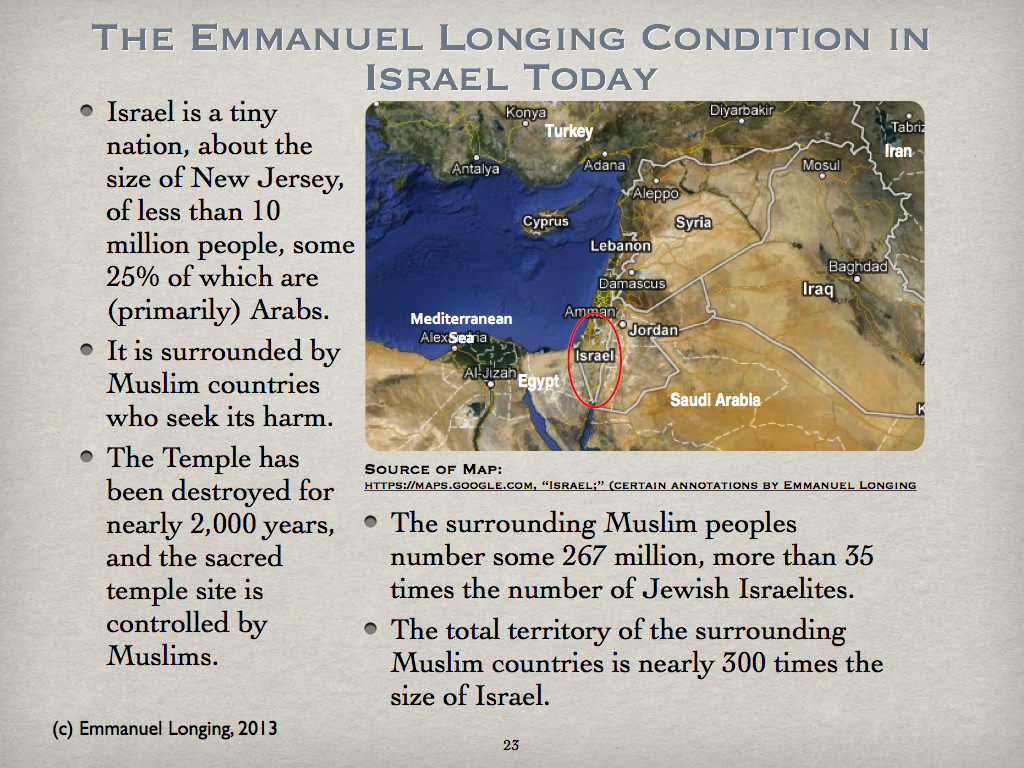 The holiest place for religious Jews today is the Western (or Wailing) Wall shown below, on an exceptionally uncrowded hot September morning in 2011.
The holiest place for religious Jews today is the Western (or Wailing) Wall shown below, on an exceptionally uncrowded hot September morning in 2011.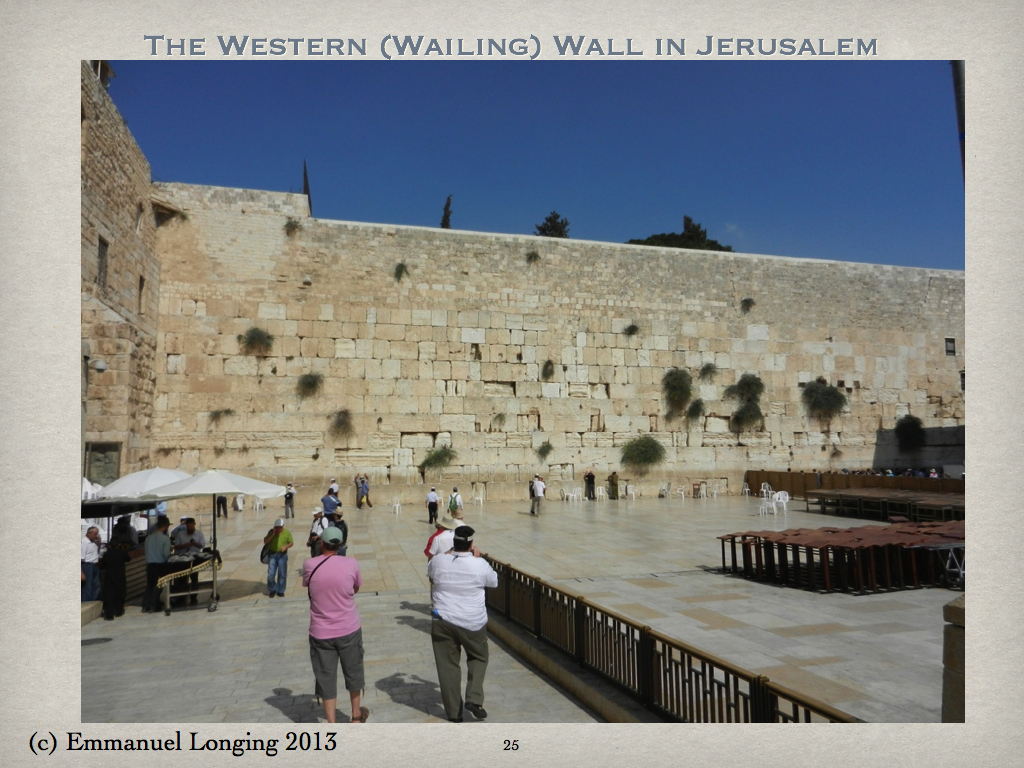 This Wall conveys special meaning to all Jews because it is the remnant of the ancient wall that existed more than 1,000 years ago. Somewhere at its base there are likely stone blocks or fragments dating back even to Kingdom Period of the Old Testament (ca. 3,000 years ago).
This Wall conveys special meaning to all Jews because it is the remnant of the ancient wall that existed more than 1,000 years ago. Somewhere at its base there are likely stone blocks or fragments dating back even to Kingdom Period of the Old Testament (ca. 3,000 years ago).
However the presently visible Western Wall is only a small portion of what it was at the time of Herod the Great and Jesus Christ. Shown below in red are the dimensions of the Wall then compared to its present dimensions (shown in black). So when one stands at the face of the Wall today, one stands upon 40 plus feet of rubble that has accumulated over 2,000 years of battles, earthquakes, building, and re-building:
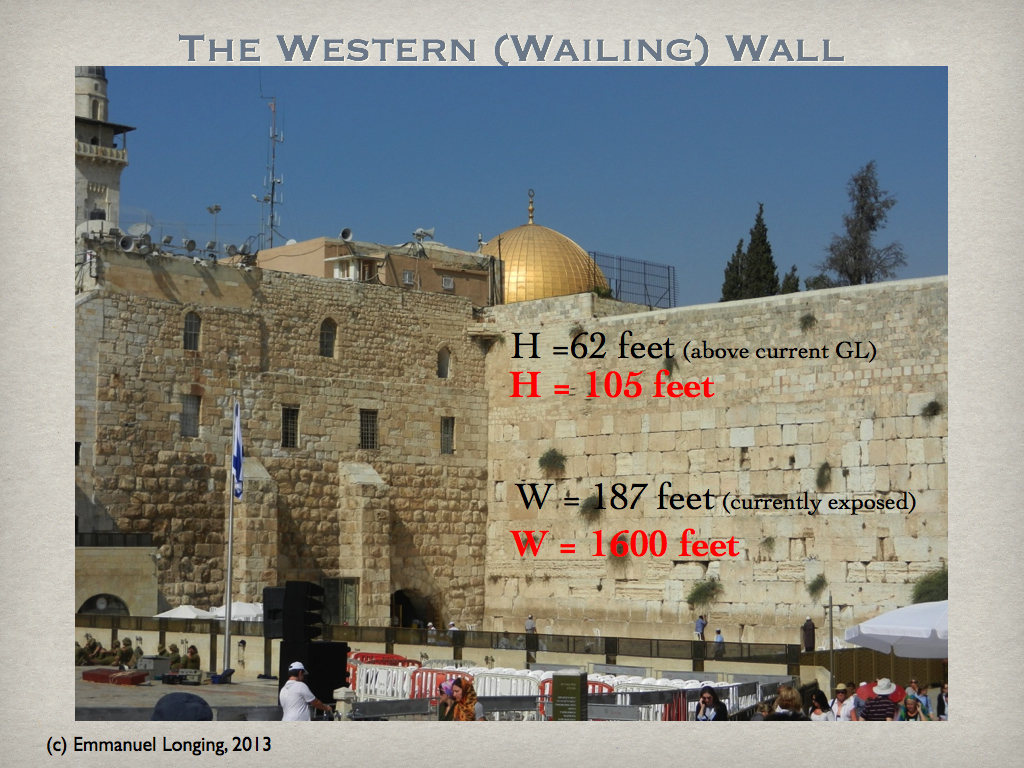 Off to the left in the above picture, and shown below, there is a visible demonstration of the massive amount of material that covers the original street level. Shown below is a narrow, well-like escavation down more than 40 feet to the level at the time of Christ. Some of the blocks comprising the Wall down below present ground level bear the resemblance to the kind that were used during the reign of Herod the Great, and some blocks and stones may even date back to the time of the early period of the Second Temple, or even back to the First Temple period:
Off to the left in the above picture, and shown below, there is a visible demonstration of the massive amount of material that covers the original street level. Shown below is a narrow, well-like escavation down more than 40 feet to the level at the time of Christ. Some of the blocks comprising the Wall down below present ground level bear the resemblance to the kind that were used during the reign of Herod the Great, and some blocks and stones may even date back to the time of the early period of the Second Temple, or even back to the First Temple period: 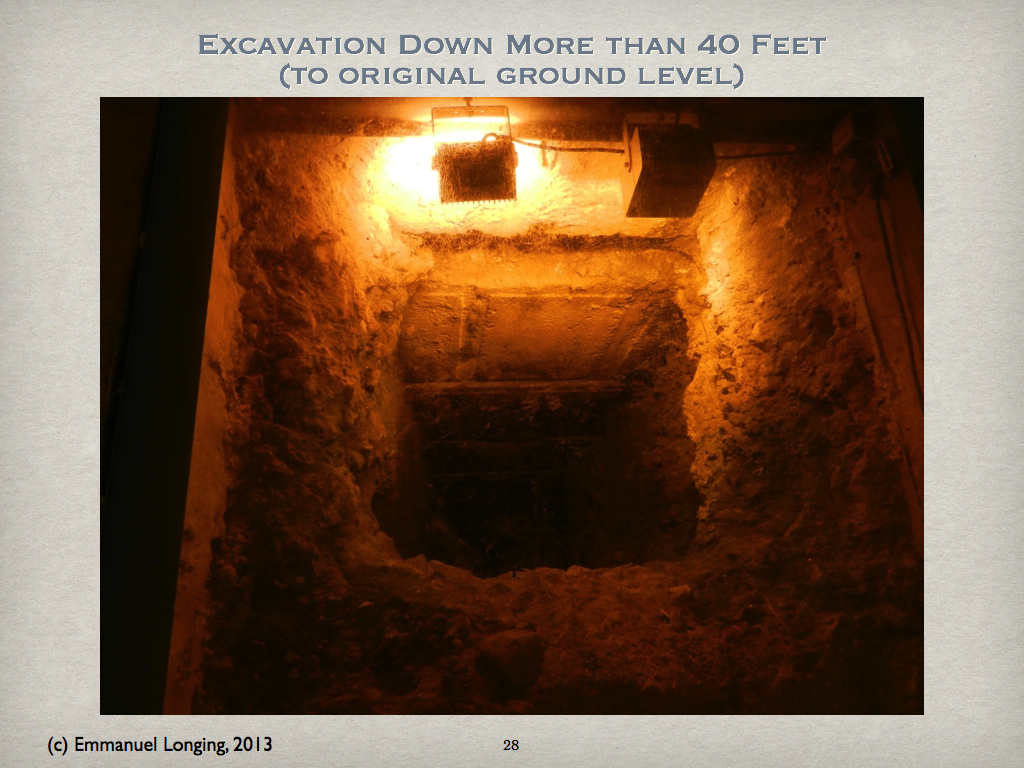 The Wall helps open an expression of the deepest longing on the part of serious pilgrims of the ancient Hebrew faith. Some come to the Wall to contemplate the history of it, especially in the context of Jewish history. Others fall into the most awesome reverent humility before what they feel is the very real presence of God. And many people of all manner of personal dispositions slip small notes into the wall.
The Wall helps open an expression of the deepest longing on the part of serious pilgrims of the ancient Hebrew faith. Some come to the Wall to contemplate the history of it, especially in the context of Jewish history. Others fall into the most awesome reverent humility before what they feel is the very real presence of God. And many people of all manner of personal dispositions slip small notes into the wall.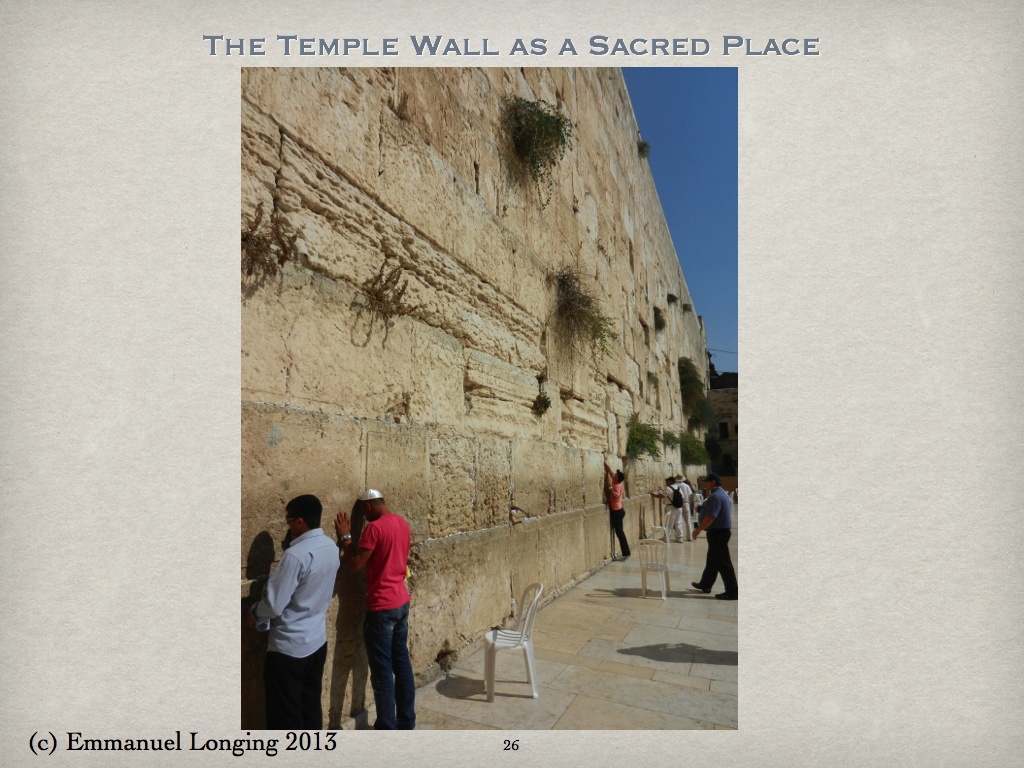 Every crack, however, small, is jammed with small notes written to reach across both the spatial boundary of the Wall and also across the great span of time. Some of these notes are expressions of thanks to the God of the Hebrews (YHWH, Lord), others are prayers from some personal need, still others expressing some form of the longing for re-establishing a physical connection with YHWH…the Emmanuel Longing that is our primary interest here.
Every crack, however, small, is jammed with small notes written to reach across both the spatial boundary of the Wall and also across the great span of time. Some of these notes are expressions of thanks to the God of the Hebrews (YHWH, Lord), others are prayers from some personal need, still others expressing some form of the longing for re-establishing a physical connection with YHWH…the Emmanuel Longing that is our primary interest here.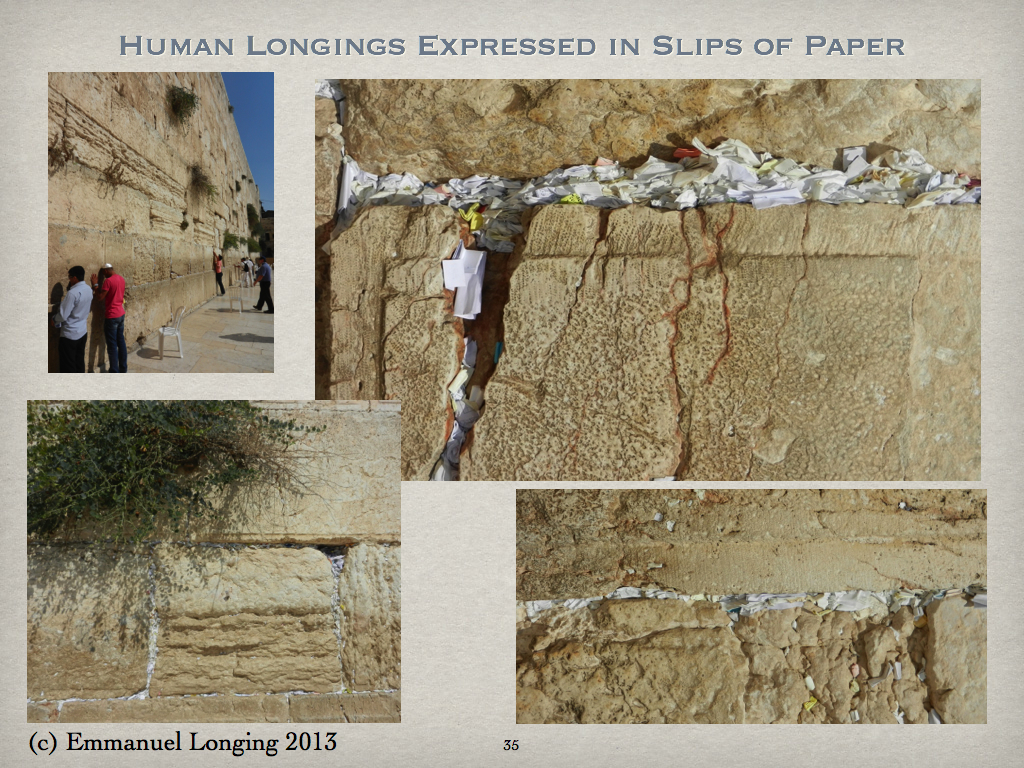 Each slip of paper, perhaps a million separate ones each year, are a not like the proverbial “messages in a bottle” which are written to an unknown / anyone; these “messages-in-the-Wall” are seeking to cross the boundary of space-time and reach the awareness of the eternal, highest, most magnificent Being, Who is now silent, absent from the Temple and estranged from His unique space-time site, lying perhaps just a hundred feet beyond and above these cracks.
Each slip of paper, perhaps a million separate ones each year, are a not like the proverbial “messages in a bottle” which are written to an unknown / anyone; these “messages-in-the-Wall” are seeking to cross the boundary of space-time and reach the awareness of the eternal, highest, most magnificent Being, Who is now silent, absent from the Temple and estranged from His unique space-time site, lying perhaps just a hundred feet beyond and above these cracks.
Now, let us turn to consider further the Old Testament history of the Temple.